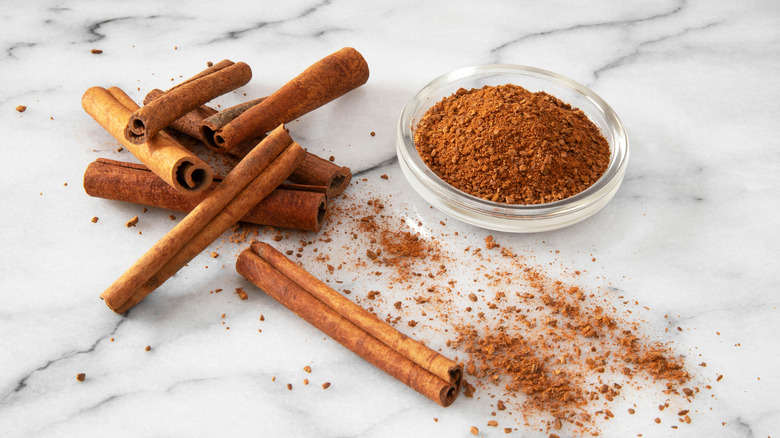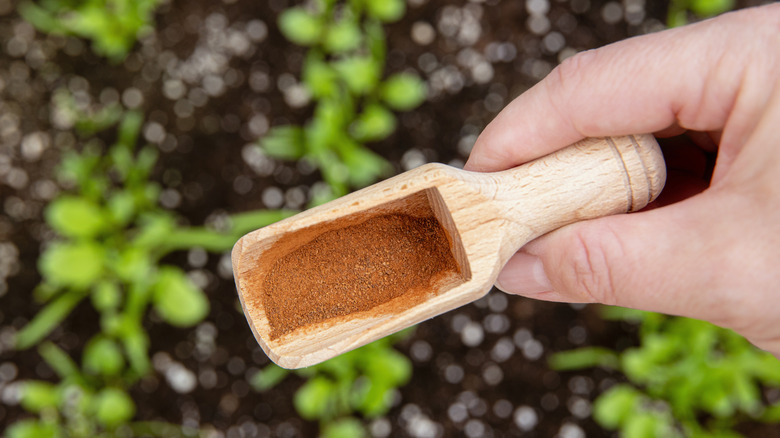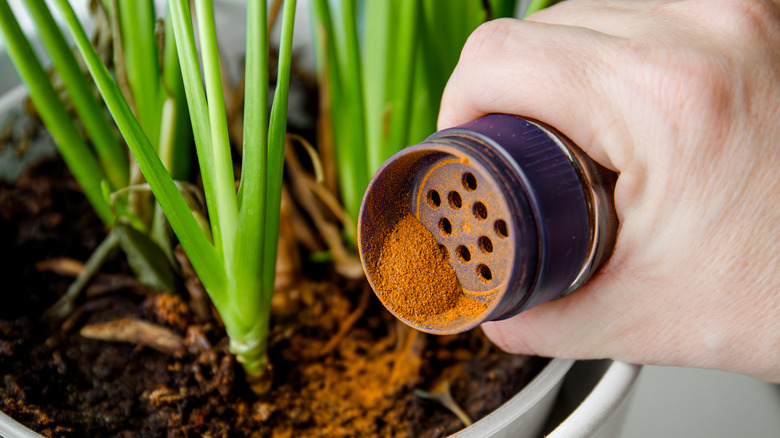The Plus Sides And Downsides Of Using Cinnamon In The Garden
Cinnamon is a spice made from the bark of the evergreen cinnamon tree. This fragrant spice is common in kitchens all across the United States, invoking feelings of comfort with the scent of spiced cider and gooey cinnamon rolls. This widely-available spice isn't just a staple in the kitchen, though. You can use it as a car freshener and home deodorizer, or even use ground cinnamon to erase furniture scratches. Another beneficial area to use cinnamon is in your yard and garden.
Cinnamon is a great natural way to tend to your garden without harmful chemicals. It's a rooting agent for plants, as well as a pest and disease deterrent. A sprinkle of cinnamon can also stimulate plant cuttings and help keep fungus out of your garden. Despite all these advantages, using cinnamon on plants can also come with drawbacks, so it's crucial to make sure you're using it correctly.
Benefits of using cinnamon in your garden
Cinnamon is a natural and effective alternative to chemical treatments that supports growing a healthy garden. As a rooting agent, this spice stimulates root growth in cuttings, giving new plants a strong start. Simply roll the damp stem ends in cinnamon powder before planting them in soil. Cinnamon can also prevent damping-off disease, a common fungal issue in seedlings, by killing the fungus and protecting delicate roots. When used as a spray, cinnamon helps control other fungal issues like slime mold and mushroom growth. Create a spray by mixing a bit of cinnamon with warm water, leaving it overnight, then straining the mixture through a coffee filter and pouring the water into a spray bottle. Cinnamon's dual action of both encouraging growth and resisting disease makes it a go-to remedy for anyone starting plants from cuttings in their garden.
Beyond its benefits for propagation, cinnamon also serves as a gentle yet powerful natural ant repellant. Using cinnamon as an ant deterrent, whether in powdered or essential oil form, can keep these bugs away; it won't kill them, but thanks to a compound known as cinnamaldehyde, ants will avoid it. Sprinkle cinnamon over your most infested areas — whether that's your garden, greenhouse, or even your kids' sandbox — to repel ants without harmful chemicals. With such wide-ranging uses, cinnamon can become your daily gardening essential for natural plant care.
When to steer clear of cinnamon
Despite the benefits, cinnamon should still be used with caution. It's recommended that you avoid using it on certain plants. For instance, the growth of garden cress can be hindered by cinnamon, while peppers, orchids, ferns, and prayer plants can end up with damaged leaves and roots because of this potent spice.
There are several types of cinnamon, and knowing which type you have can help you avoid unintentionally harming your plants. All cinnamon contains coumarin, a compound that's toxic to plants and humans in high doses. Ceylon cinnamon, known as "true" cinnamon, has lower levels of this compound, so it's a bit safer to use on plants. However, cassia cinnamon is the far more common variety and is likely what's in your pantry. Its higher concentration of coumarin means it should be used more sparingly. Because of the risk of toxicity, it's recommended that you start applying cinnamon to plants lightly at first. Test on a small, inconspicuous area before applying elsewhere so you don't damage or kill the whole plant.


